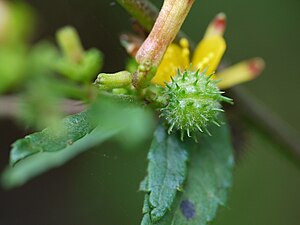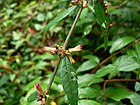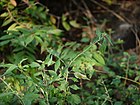Note: This is a project under development. The articles on this wiki are just being initiated and broadly incomplete. You can Help creating new pages.
Triumfetta rhomboidea
Paroquet bur is an erect shrub or perennial herb with stems that are woody at the base, growing up to 1.5 metres tall. The plant has a number of local uses - it has various medicinal applications; yields a good fibre; and has somewhat edible leaves. It was at one time cultivated in Malawi as a fibre crop.
Uses
Parts Used
Chemical Composition
Preliminary phytochemical screening of both the extracts utilizing standard methods of analysis revealed the presence of steroid, triterpenoids, glycosides, flavonoids etc.[2]
Common names
| Language | Common name |
|---|---|
| Kannada | ಕಾಡುಬೆಂಡೆ Kaadu bende |
| Hindi | Chikti |
| Malayalam | Oorppam |
| Tamil | Kapotam |
| Telugu | Bankatuttara |
| Marathi | Jhinjhardi |
| Gujarathi | Jhipato |
| Punjabi | |
| Kashmiri | |
| Sanskrit | Jhinjhirita |
| English | Burr Bush, Chinese burr |
Properties
Reference: Dravya - Substance, Rasa - Taste, Guna - Qualities, Veerya - Potency, Vipaka - Post-digesion effect, Karma - Pharmacological activity, Prabhava - Therepeutics.
Dravya
Rasa
Guna
Veerya
Vipaka
Karma
Prabhava
Habit
Identification
Leaf
| Kind | Shape | Feature |
|---|---|---|
| Simple | Alternate | Blade ovate to rhomboid |
Flower
| Type | Size | Color and composition | Stamen | More information |
|---|---|---|---|---|
| Obovate | 5mm long | It is small in size | Flowering season is June-February |
Fruit
| Type | Size | Mass | Appearance | Seeds | More information |
|---|---|---|---|---|---|
| 1-1.5mm long | Covered with 75 to 100 hooked spines, Fruiting season is June-February |
Other features
List of Ayurvedic medicine in which the herb is used
Where to get the saplings
Mode of Propagation
How to plant/cultivate
The plant produces seed capsules covered in hooked spines that adhere strongly to animal fur, clothing etc, and are thus easily transported to new sites.[5]
Commonly seen growing in areas
Photo Gallery
References
- ↑ Indian Medicinal Plants by C.P.Khare
- ↑ Chemical constituents
- ↑ Common names
- ↑ Kappatagudda - A Repertoire of Medicianal Plants of Gadag by Yashpal Kshirasagar and Sonal Vrishni, Page No. 378
- ↑ Cultivation
External Links
- Ayurvedic Herbs known to be helpful to treat Internal ulcerations
- Ayurvedic Herbs known to be helpful to treat Diarrhoea
- Ayurvedic Herbs known to be helpful to treat Dysentery
- Ayurvedic Herbs known to be helpful to treat Internal haemorrhages
- Ayurvedic Herbs known to be helpful to treat Gonorrhoea
- Ayurvedic Herbs known to be helpful to treat Boils
- Herbs with Leaves used in medicine
- Herbs with Stem used in medicine
- Herbs with common name in Kannada
- Herbs with common name in Hindi
- Herbs with common name in Malayalam
- Herbs with common name in Tamil
- Herbs with common name in Telugu
- Herbs with common name in Marathi
- Herbs with common name in Gujarathi
- Herbs with common name in Sanskrit
- Herbs with common name in English
- Habit - Shrub
- Index of Plants which can be propagated by Seeds
- Herbs that are commonly seen in the region of An abundant weed along roads
- Herbs that are commonly seen in the region of Waste places
- Herbs that are commonly seen in the region of Thickets
- Herbs that are commonly seen in the region of Canefields
- Herbs








